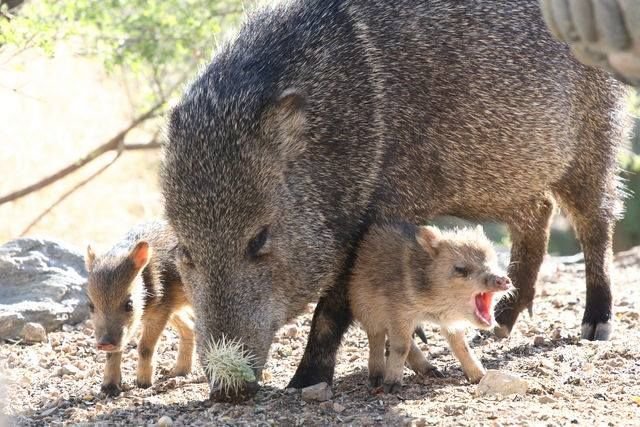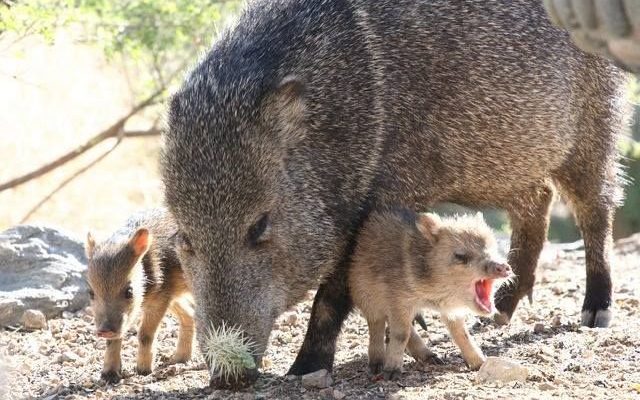
When it comes to distinguishing javelinas from their lookalikes, it’s all about the details. Some animals share similar physical traits, habitats, or behaviors, and knowing how to tell them apart can be quite fascinating. Grab a cup of coffee, and let’s explore ten animals that are similar to the javelina and discover what makes each one special.
1. Wild Boar
The wild boar is perhaps the most obvious lookalike to the javelina. Both animals have similar body shapes and tusks, but here’s the thing: wild boars are significantly larger. They can weigh up to 400 pounds, while javelinas typically max out around 90 pounds.
In terms of habitat, wild boars are widespread, found across Europe, Asia, and even in North America where they’ve been introduced. They have a bristly coat of dark hair and can look quite formidable. Javelinas, on the other hand, have a more uniform grayish-brown coat and are usually found in smaller groups, often called a sounder.
If you’re trying to identify one from the other, pay attention to the ears. Javelinas have small, rounded ears compared to the larger, more pointed ears of wild boars.
Distinguishing Features
- Size: Wild boars are larger.
- Ears: Javelinas have smaller, rounded ears.
- Habitat: Wild boars are more widespread.
2. Domestic Pig
Imagine a javelina but with an extra helping of domesticity, and you’ve got the domestic pig. These familiar farm animals share some physical traits with javelinas, especially the snout and body shape. However, domestic pigs can vary enormously in size, from tiny teacup breeds to hefty farm varieties.
One of the easiest ways to tell them apart is by observing their behavior. Domestic pigs are often seen in pens or around farms, while javelinas roam freely in the wild. Plus, domestic pigs tend to be much friendlier, often looking for food and interactions.
With their varied coat colors and sizes, domestic pigs also have a more diverse appearance than the uniform brownish-gray of javelinas.
Key Differences
- Behavior: Domestic pigs are tamer and often seen on farms.
- Appearance: Domestic pigs come in various colors and sizes.
- Habitat: Javelinas are wild animals.
3. Capybara
Next up is the adorable capybara. These animals are the largest rodents in the world and might surprise you with their similarities to javelinas. Both species have a stocky build and short legs. Capybaras are often found near water sources, making them a bit different in their preferred habitat.
While javelinas are part of the peccary family, capybaras belong to the rodent family. Their fur is a bit rougher, and their faces are rounder, giving them a fluffy look. If you see a group of capybaras, they usually hang out in the water or on land in family units, just like javelinas do.
But how do you spot a capybara? Check out their webbed feet—perfect for swimming!
Spotting Differences
- Family: Javelinas are peccaries; capybaras are rodents.
- Habitat: Capybaras love water.
- Feet: Capybaras have webbed feet.
4. Peccary
Surprisingly, the peccary isn’t a totally different animal from the javelina. In fact, javelinas are a type of peccary. However, there are different species of peccaries, like the collared peccary and the white-lipped peccary.
While they share many characteristics—like size and social behavior—collared peccaries have a noticeable white stripe across their backs, which you won’t find on a javelina. White-lipped peccaries, on the other hand, are larger and have a more pronounced snout. So, while they are family, you can definitely see the differences if you know what to look for!
Family Ties
- Species: Javelinas are a type of peccary.
- Markings: Collared peccaries have a white stripe.
- Size: White-lipped peccaries are larger.
5. Warthog
Ever seen a warthog? If not, just picture a wild pig with some serious attitude. Warthogs have similar tusks and stocky bodies, which can make them look like distant relatives of javelinas. However, they’re much larger, and their facial structure is quite different.
Warthogs have elongated heads and are usually seen in Africa, whereas javelinas are native to the Americas. They have a unique way of moving, often resting on their knuckles while foraging for roots and tubers.
If you spot them in the wild, their distinctive facial warts (which are actually protective pads) set them apart from javelinas.
Warthog vs. Javelina
- Habitat: Warthogs are African.
- Head shape: Warthogs have elongated faces.
- Size: Warthogs are significantly larger.
6. Baird’s Tapir
Baird’s tapir might not be the first animal that comes to mind when thinking about javelinas, but they share some surprising similarities. Both have stout, rounded bodies and small, rounded ears. Tapirs, however, are much larger and can weigh up to 800 pounds.
They have a distinct long snout, which they use to grasp leaves and fruits, unlike the more pronounced snout of a javelina. While javelinas prefer dry habitats, tapirs thrive near rivers and forests in Central America and parts of South America.
Their fur generally appears darker, and they have a pretty unique pattern of spots and stripes when they’re young, which makes them look adorable!
Identifying Features
- Size: Baird’s tapirs are much larger.
- Snout: Tapirs have a long, flexible snout.
- Habitat: Tapirs live near water sources.
7. Asian Wild Boar
Similar to the wild boar, the Asian wild boar shares many traits with javelinas. However, they tend to have a slightly smaller build and have dark, coarse fur. Unlike wild boars, which can be quite aggressive, Asian wild boars are known for being a bit more reclusive.
They roam forests and grasslands in Asia, often forming smaller groups compared to their European counterparts. When trying to distinguish them from javelinas, look for their longer legs and more slender frame.
Comparison Points
- Habitat: Asian wild boars are found in Asia.
- Behavior: They are generally more shy and reclusive.
- Build: They have longer legs and a slimmer frame.
8. Red River Hog
The red river hog is another fascinating animal that can resemble javelinas. With their reddish-brown fur and stout bodies, they can easily be confused at first glance. However, these hogs are much larger and are found in the rainforests of West Africa.
They have a striking mane of hair along their spines and are known for their charmingly curious nature. When comparing them to javelinas, you’ll notice the red river hog has a longer, more elongated snout, which is perfect for digging in the ground for food.
Highlights to Note
- Habitat: Red river hogs are rainforest dwellers.
- Color: They have reddish-brown coats.
- Snout: Longer and more elongated than javelinas.
9. Mangalica Pig
Have you heard of the Mangalica pig? Often called the “sheep pig,” it has a curly coat that can mislead you at first glance. Though they’re a domestic breed, their stocky build and similarities to javelinas make them a notable mention.
Mangalica pigs have a thicker, more woolly coat compared to the sleek fur of a javelina. While they are friendly and raised primarily for meat, they share common behaviors like rooting around for food. You’ll find them on farms in Hungary and neighboring areas, where they are quite popular.
Noteworthy Comparisons
- Coat: Mangalica pigs have a curly, wool-like coat.
- Behavior: Both animals enjoy foraging.
- Size: Mangalica pigs can reach significant sizes.
10. Eurasian Badger
Lastly, let’s look at the Eurasian badger. While they aren’t direct relatives, they share certain characteristics with javelinas, such as their stocky bodies and social nature. Badgers have a more compact shape and are often recognized by their black-and-white facial markings.
You might find badgers digging around for insects and roots, similar to what javelinas do. However, badgers are primarily nocturnal and prefer a more solitary lifestyle compared to the social javelinas.
Final Distinctions
- Markings: Badgers have striking black-and-white markings.
- Behavior: Badgers are mostly solitary and nocturnal.
- Habitat: Badgers prefer forests and grasslands.
In conclusion, while javelinas might share their charm with various other animals, recognizing their unique traits is part of the fun. Whether it’s their coat color, body structure, or social habits, each creature brings something special to the table. The next time you spot a javelina or one of its lookalikes, take a moment to appreciate those differences. It’s like spotting family traits in a large gathering—every animal has its own story to tell!

